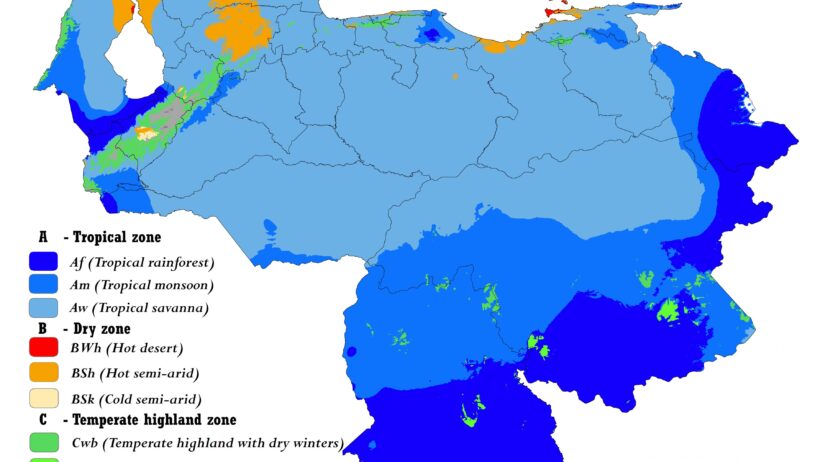The climate in Venezuela is a tapestry woven from diverse ecological zones influenced by geography, altitude, and latitude. Covering a territory that stretches from the tropical coastlines of the Caribbean Sea to the lofty peaks of the Andes, the country presents a unique climate profile characterized by a plethora of microclimates. Understanding these distinctions is essential for appreciating not only Venezuela’s natural splendor but also the complexities of its environmental challenges.
The Venezuelan landscape is predominantly tropical, with the majority of the country enjoying a warm climate year-round. Coastal regions, especially in the north, are marked by high humidity and balmy temperatures. Along the Caribbean coast, cities like Caracas and Maracaibo experience average annual temperatures that hover around 27°C (81°F). The coastal climate is influenced by the warm waters of the Caribbean, engendering a tropical rainforest climate in certain areas. Consequently, these regions witness abundant precipitation, leading to lush vegetation and vibrant ecosystems.
Moving inland, one encounters the expansive Llanos, a vast tropical grassland that transitions into a drier tropical savanna climate. This area encompasses a rich biodiversity, with seasonal fluctuations dictating the water availability and consequently affecting both flora and fauna. Here, the wet season can be quite pronounced, with substantial rainfalls typically occurring between April and November, while the dry season, which can last from December to March, leads to harsher conditions for both wildlife and local communities.
Ascending into the Andean region unveils a starkly different climatic reality. The altitudes soar, with peaks exceeding 4,000 meters (13,123 feet), leading to a cooler, more temperate environment. The climate here varies significantly with elevation. The lower ranges are characterized by a humid subtropical climate, while the higher elevations transition to a cold, alpine climate. At such altitudes, temperatures can plummet sharply, particularly at night, necessitating unique adaptations in both plant and animal life.
The contrasting climatic zones across Venezuela give rise to various microclimates, each teeming with its own distinct ecosystems. The Amazon rainforest in the south, for instance, showcases a hot and humid environment, where the seasons are delineated more by precipitation than temperature. The annual average temperature hovers around 25°C (77°F) to 30°C (86°F), exemplifying the heat that fuels one of Earth’s most biodiverse regions. The combination of rich soil, dense foliage, and high humidity fosters an exceptional array of wildlife, including rare and endangered species.
Beyond just temperature and precipitation, the climate’s impact on Venezuelan agriculture, economy, and populations cannot be overstated. The agricultural sector relies heavily on climatic conditions, and the varied climates allow for the cultivation of a wide range of crops, from tropical fruits in the lowlands to potatoes and corn in the cooler Andean slopes. This diversity fosters economic resilience, yet it also poses challenges, such as susceptibility to extreme weather events linked to climate change.
Climate change is profoundly altering Venezuela’s weather patterns, exacerbating both the frequency and severity of droughts and floods. Anomalies in precipitation have resulted in growing concerns about water scarcity, particularly impacting rural communities that depend on agriculture. The changes in weather patterns lead to soil erosion and deplete the land’s productivity, presenting a significant threat to food security. This is of particular relevance given Venezuela’s reliance on its vast natural resources, which are becoming increasingly vulnerable to the whims of a changing climate.
The socio-economic implications of these climatic variations are multifaceted. The northern coastal regions experience urban heat islands due to rapid urbanization, with rising temperatures prompting health concerns and increased energy consumption. In contrast, the more temperate Andean areas face issues related to agriculture and the sustainability of local communities. As climates shift, populations are compelled to migrate, either seeking better conditions within the country or attempting to cross borders into neighboring nations.
Tourism also occupies a delicate balance with the climate, as many visitors are drawn to Venezuela’s climatic diversity. The picturesque beaches of Los Roques contrast sharply with the majestic Andes, making the nation a hotbed for adventure tourism. However, with rising ecological threats and the diminishing natural habitats caused by climate change, the tourism sector’s sustainability is under scrutiny.
Furthermore, the intricate waterways of Venezuela, such as the Orinoco and the Caroni Rivers, are vital components of the climate system. These rivers support both the biodiversity of the ecosystems they traverse and the livelihoods of local communities. Climate changes, such as shifts in rainfall patterns, can have cascading effects on these waterways, impacting both ecosystems and the populations that depend on them. The interdependence of water, climate, and human activity underscores the need for integrated approaches to environmental management.
In summary, the climate of Venezuela is characterized by remarkable diversity, encompassing tropical coastal environments, savannas, and high-altitude regions. The interplay between temperature, rainfall, and elevation fosters a rich tapestry of ecosystems that support vibrant flora and fauna. However, these climatic conditions are increasingly under threat due to the implications of climate change, with significant socio-economic consequences. Addressing these challenges is essential for the preservation of Venezuela’s natural heritage and the well-being of its people, necessitating an urgent focus on sustainable practices and climate resilience strategies.





